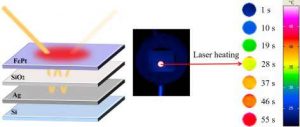R&D: Nanocavity Induced Light Concentration for Energy Efficient HAMR Media
Highly scalable for thinner FePt layers and shorter wavelengths to be used in future HAMR technologies.
This is a Press Release edited by StorageNewsletter.com on July 3, 2018 at 2:22 pmNano Energy has published an article written by Chenhua Deng,College of Chemistry and Materials Science, Shanxi Normal University, Linfen 041004, China, Department of Physics, University at Buffalo, SUNY, Buffalo, New York 14260, USA, and College of Chemistry, Taiyuan Normal University, Jinzhong 030619, China, Haomin Song, Department of Electrical Engineering, University at Buffalo, SUNY, Buffalo, New York 14260, USA, James Parry, Department of Physics, University at Buffalo, SUNY, Buffalo, New York 14260, USA, Yihao Liu, Shuli He, Department of Physics, Capital Normal University, Beijing 100048, China, Xiaohong Xu, College of Chemistry and Materials Science, Shanxi Normal University, Linfen 041004, China, Qiaoqiang Gan, Department of Electrical Engineering, University at Buffalo, SUNY, Buffalo, New York 14260, USA, and Hao Zeng, Department of Physics, University at Buffalo, SUNY, Buffalo, New York 14260, USA.
Abstract: “Enhancing light absorption in the recording media layer can improve the energy efficiency and prolong the device lifetime in heat assisted magnetic recording (HAMR). In this work, we report the design and implementation of a resonant nanocavity structure to enhance the light-matter interaction within an ultrathin FePt layer. In a Ag/SiO2/FePt trilayer structure, the thickness of the dielectric SiO2 layer is systematically tuned to reach maximum light absorption at the wavelength of 830 nm. In the optimized structure, the light reflection is reduced by more than 50%. This results in effective laser heating of the FePt layer, as imaged by an infrared camera. The scheme is highly scalable for thinner FePt layers and shorter wavelengths to be used in future HAMR technologies.“















 Subscribe to our free daily newsletter
Subscribe to our free daily newsletter

